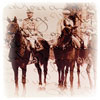William George Calder was born in Truro, Nova Scotia, in 1898 and later lived in Ashcroft, British Columbia, prior to the war. He enlisted in Vancouver, British Columbia, in May 1916, served overseas, and returned to Canada in 1919. The collection consists of more than forty letters, extensive images, both photographs and postcards, as well as diaries and numerous miscellaneous items.

Title
WWI
These collections contains any material relating to Canada from 1914 to 1918 from either the home front or the battlefront. External links in collection descriptions are either to online attestation papers at Library and Archives Canada or casualty and burial information at the Commonwealth War Graves Commission.
George Cameron was born in Sarnia, Ontario, in 1893 and enlisted in the artillery there in May 1917. He served in the 7th Battery, Canadian Field Artillery in France and Belgium. The diary covers his experiences in England and at the front from January 1918 to March 1919.
William Lockhard Campbell was born in 1897 in Owen Sound, Ontario. He later moved to Carleton Place, Ontario, where he enlisted in September 1914 with the 2nd Battalion, Canadian Expeditionary Force. Campbell served overseas in France and was killed in action April 22, 1915. He has no known grave. The collection consists of two letters.
Private William Nelson Campbell, known as “Nelson,” was born in Clyde, Ontario, on December 28, 1894. He enlisted with the 1st Battalion Canadian Infantry in Valcartier, Québec, on September 19, 1914. Sent into action in France in February 1915, he remained with the 1st Bn. throughout most of the war.
Campbell was killed by snipper fire during an attack on the Canal-Du-Nord, near Haynecourt, on September 27, 1918. He is buried in the Ontario Cemetery at Sains-les-Marquion in France.
Most of the letters in the Campbell collection were written by Nelson to his cousin Ester "Essie" Douglas. Nelson’s mother Mary Anne "Annie" Campbell (née Nelson) was the sister of Essie’s mother Ester Douglas (née Nelson). Orphaned at a young age, Nelson lived for much of his childhood with his widowed Aunt Ester and his six Douglas cousins, four girls and two boys, in Orchardville, Ontario. Essie was the youngest of the girls, and quite close in age to Nelson, being just one year his junior. The final letter in the collection was written to Essie by Corporal W.A. McArthur, a mutual friend of herself and Nelson.
External links:
Pte. Campbell's service record (Reg/Ser# 7224) is available online through Library and Archives Canada.
Burial information is available at the Commonwealth War Graves Commission.
A memorial page honouring him can be visited online at the Canadian Virtual War Memorial.
Frederick Ernest Carter was born in Essex, England, in 1871 and immigrated to Kamloops, British Columbia, sometime prior to the war. His wife died in 1912, leaving him with two small children. Carter enlisted in May 1915 at the age of 44. He served overseas in France where he was killed in action April 14, 1916, leaving behind two orphaned daughters in Canada. The collection consists of four letters.
Winifred Chapman was born in 1900 and worked at the Tankerton Hospital, Kent, England during the First World War. She kept an autograph book from her time there, which includes inscriptions from four Canadians. There is an incription from Pte. Bruce Nelson Sandford, 27th Battalion from September 29, 1918; an inscription from G. West, 78th Battalion, from September 29, 1918; an undated incription from Pte. Ryan, 26th Battalion; and an undated inscription from Cpl. Thomas Wells.
George Roderick Chisholm was born in Pictou, Nova Scotia, on March 15, 1897. Chisholm enlisted with the 78th Battalion of the Canadian Overseas Expeditionary Force in April 1916. He served in France and was killed at Vimy Ridge April 9, 1917.This collection consists of a note written by Chisholm three days prior to the attack on Vimy Ridge and his Circumstances of Death record.
James R. Chisholm was born in Inverness, Scotland, in 1885 and immigrated to Canada sometime prior to the war. He enlisted at Lethbridge, Alberta, in December 1914. James served overseas in France and was killed June 3, 1916. Alexander Chisholm was born in Inverness, Scotland, in March 1888 and immigrated to Canada prior to the war. He enlisted in Brandon, Manitoba, in April 1915. He served overseas in France and was killed October 9, 1916. The collection consists of one undated photograph of the brothers.
Lieutenant Frank Charles Clark was born in Gloucester, England, on April 26, 1886. He worked as a carpenter and rancher in Kamloops, British Columbia, and prior to his enlistment he had served seven years in the militia with the 102nd Regiment, Rocky Mountain Rangers.
Clark enlisted on January 1, 1916, in Kamloops, B.C., with the 172nd Battalion and proceeded to England in October 1916. Once there he was transferred to the 24th Reserve Battalion, and then to the 47th Battalion. While serving with the 47th, Clark was wounded at Passchendaele in October 1917, and evacuated to hospitals in England until the spring of 1918. He remained in England until the end of the war, and was then demobilized and returned to Canada in January 1919.
Content notes:
The collection’s letter was written by Clark to his wife, Elizabeth Duncan Clark, in April 1917.
External links:
Lt. Frank Clark’s service record (Serv/Reg# 687005) can be viewed/downloaded in pdf format through Library and Archives Canada.
External links for other identified soldiers appearing in Clark’s letters:
Lt. Desmond Odlum Vicars, service record (Serv/Reg# 687308).
Sgt. John Munro Knox, service record (Serv/Reg#687006).
Cadet Robert Stephen MacKay, service record (Serv/Reg# 688061).
Pte. Gordon Alexander McArthur, service record (Serv/Reg# 687610).
William Orlando Clay was born in Newmarket, Ontario, in February 1885. He enlisted in February 1916 in Toronto with the 180th Battalion. The collection currently consists of his discharge certificate, several photos, and his diary from 1916.
George William Cochrane was born in July 1893 in Portage la Prairie, Manitoba. Cochrane enlisted in March 1916 in Winnipeg, Manitoba, with the 196th Battalion. He served overseas with the 46th Battalion and died of wounds April 14, 1917. The collection currently consists of three letters, three photographs, and two newspaper clippings.
Lieutenant Robert Grierson Combe, VC, was born in Aberdeen, Scotland, in 1880. He immigrated to Moosomin, Saskatchewan, where he worked as a chemist. He enlisted at Prince Albert, Saskatchewan, in April 1915 [note: there is a discrepancy between his attestation papers which date his enlistment as 1915 and other records which date his enlistment as 1916]. He was killed on May 3, 1917, and has no known grave. He was posthumously awarded the Victoria Cross for his bravery. The collection consists of one letter to his grammar school magazine and his citation for bravery.
Horace Kelvin Conners was born in May 1893 in Montreal, Québec. Conners enlisted in Montreal in June 1915 and served overseas with the 60th Battalion until he was demobilized and returned to Canada in 1919. The collection currently consists of five letters, as well as numerous postcards and photographs. See also the collection of his brother, Robert John Conners.
Robert John Conners was born in Montreal, Québec, in October 1890. Conners enlisted in Montreal in January 1917 and served in France with the Broad Gauge Railway Operating Company. He was demobilized and returned to Canada in 1919. The collection currently consists of one letter and two photographs. See also the collection of his brother, Horace Kelvin Conners.
Allan Matheson Conquergood was born in Kincardine, Ontario, in May 1872. He enlisted in July 1916 in Winnipeg with the 239th Battalion, the Railway Construction Corps, and served overseas. The collection currently consists of his diary from 1917.
Alfred Frank Cook was born in Midland, Ontario, in August 1894. Cook was a law student who enlisted in August 1915 in Niagara, Ontario, with the 58th Battalion. He served overseas with the 58th Battalion until 1918 when he transferred to the R.A.F. as a flight cadet. He was found to be medically unfit and was discharged and returned to Canada at the end of the war. The collection currently consists of thirty eight letters.
Arthur John Cook was born in Chelmsford, England, in 1892 and immigrated to Canada prior to the war. Cook enlisted in Edmonton, Alberta, in November 1914. He served overseas until the end of the war. The collection currently consists of his 1918 diary and one photograph.
Private Harold William Cooper was born in Merton, Surrey, England, on June 4, 1896, to parents John and Annie Cooper. Prior to enlistment the Cooper family was living in Moosomin, Saskatchewan.
Cooper enlisted with the 10th Canadian Mounted Rifles at Moosomin, Sask., on December 18, 1914. In May 1916 he proceeded to England with the 10th C.M.R. aboard the SS Olympic, and then in September to France where he joined the Canadian Corps Cavalry Regiment (redesignated the Canadian Light Horse in February 1917).
After several months spent in England recovering from gas poisoning, Cooper returned to France in the spring of 1918 where he joined the Fort Garry Horse. He was killed on October 9, 1918, when he was hit by machine gun fire in action near Le Cateau, France. In the final weeks of the war, following Cooper’s burial, the front lines shifted, and his grave site and remains were lost. Cooper is commemorated on the Vimy Memorial, France.
Harold Cooper’s younger brother Private Sidney Frank Cooper also served in WWI with the 10th Canadian Mounted Rifles.
Content notes:
The collection’s only photo is of Pte. Harold Cooper in Service Dress uniform.
External links:
Private Harold Cooper’s service record (Serv/Reg# 115056) can be viewed/downloaded in pdf format through Library and Archives Canada.
WWI Circumstances of Death Registers record card (page #597), Library and Archives Canada.
Burial information is available at the Commonwealth War Graves Commission.
A memorial page honouring Cooper can be visited online at the Canadian Virtual War Memorial.
Private Sidney Frank Cooper was born in Mitcham, Surrey, England, on January 4, 1898, to parents John and Annie Cooper. At the time of Sidney’s enlistment his family was living in Moosomin, Saskatchewan.
Cooper enlisted as a Bandsman with the 10th Canadian Mounted Rifles at Sewell Camp, Manitoba, on July 28, 1915. In May 1916 he proceeded to England aboard the SS Olympic and then in September to France where he joined the 27th Battalion Canadian Infantry. Following the Armistice agreement that brought an end to armed conflict, Cooper returned to Canada aboard the SS Aquitania and was demobilized on May 27, 1919.
Sidney Cooper’s older brother also enlisted in WWI with the 10th Canadian Mounted Rifles. Private Harold William Cooper was killed in France on October 9, 1918.
Content notes:
The collection’s only photo is of Pte. Sidney Cooper with (mascot?) bear cub. Also included is the 1915 Christmas greetings of the 10th Canadian Mounted Rifles.
External links:
Pte. Sidney Cooper’s service record (Serv/Reg# 155600 (orig.# 115591)) can be viewed/downloaded in pdf format through Library and Archives Canada.
Lieutenant Arthur Harold Madill Copeland was born in Winnipeg, Manitoba, on August 27, 1889. Prior to his enlistment in WWI he was a Lieutenant with the Militia’s No. 6 Canadian Army Service Corps (C.A.S.C.), Winnipeg. He enlisted for Overseas Service with the C.A.S.C. on March 8, 1915.
Beginning in March 1916, Copeland served in France with the C.A.S.C. in the 1st and 3rd Canadian Cavalry Brigade Ammunition Supply Parks. In August of 1916 he was attached to the Royal Flying Corps (R.F.C.) (technically remaining a Canadian officer, but working as a member of the British R.F.C.).
While serving as a gunner, Copeland’s plane was shot down after returning from a bombing raid; he was wounded and captured as a Prisoner of War on October 10, 1916. After a period of hospitalization to recover from gunshot wounds to his arm and leg he was transferred to the German P.O.W. Camp at Douai. Over the following two years he was moved frequently, first to Wahn bei Coln, then to Stettin, Stralsund Danholme Pommern, Augustabad bei Neubrandenburg, Schweidnitz Selesia, Holzminden, Mainz, and finally to Holzminden again.
While in captivity he was appointed to the temporary rank of Captain (a rank he kept until the end of his service). He was later “Mentioned in Reports for valuable services while in captivity, and noted accordingly in the Official Records of the Air Ministry" in the London Gazette on December 12, 1919 (see external links below). Copeland had escaped and been recaptured twice while a P.O.W. and the “valuable services” mentioned in reports may have been related to either his own escape attempts or for providing assistance to similar attempts by others.
Following his release and repatriation to England on December 14, 1918, Copeland returned to Canada and was demobilized on March 23, 1919.
The letters in the Copeland Collection were all written to Hilda R. Lailey of Toronto while Copeland was held as a German P.O.W. (following the war she became his wife; they were married for sixty-four years). With the exception of the last letter, which was written after the Armistice of Nov. 11, 1918, the letters and envelopes bear a variety of P.O.W.-related stamps indicating the content of the letters was monitored by the Germans (e.g. the first page of the letter of Nov. 14, 1916, bearing the red stamp “Geprüft. Kommandantur Wahn-Lager 63,” which roughly translates as “Checked. Headquarters Wahn-Camp 63.” The “London F.S. PAID” postmarks on the envelopes are those of the London Foreign Service.
Included in the collections “Other” contents listed below are two German documents; titled “Gefangenenlifte des Lagers,” these are pages from Prisoner Lists of the Camps, one for Wahn (western base) in January 1917, and one for Holzminden in April 1918.
The newspaper article is from the Y.M.C.A.’s wartime publication Canadian Manhood, of Jan/Feb 1917.
External links:
Lt. Copeland’s service record (Serv/Reg# not assigned) can be viewed/downloaded in pdf format through Library and Archives Canada.
Copeland’s commission as a Lieutenant was published in The London Gazette on February 2, 1916 (#29480, p. 1897), and he was “Mentioned in Reports” on December 12, 1919 (#31691, p. 15613).



